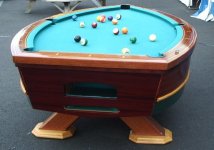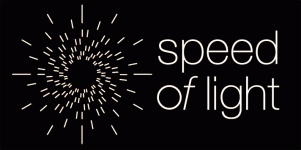It started out as fun, then I decided to prove to myself whether Einstein was right or wrong. It took me all night, and finally proved that Einstein was indeed correct.
Amazingly there are exactly 6 million possible shots when you factor the following:
1) All Distances between the Cue Ball and Object Ball (squared) X Every Possible shot speed (squared) X Every Conceivable "Tip Target" (where the cue contacts the cue ball) (squared) X Every Possible cue elevation (rounded {and squared} to the tenth degree)
No matter how I arrange the results from these calculations they always equal 6,000,000 - and what's really strange is it's the exact same number in Billiards. Also, I had to use a firm, controlled grip - with a "loose grip" with a "long follow through" shoots the number up to 60,000,000 - interesting, very, very interesting.
How could Einstein have possibly known? Was he secretly a world class pool player? Did his pool playing abilities factor into his Theory of Relativity?
I'm going to assume that you're being facetious since when I plug in 10 cue ball distances (SUPER conservative number)squared * 5 possible shot speeds (again... VERY conservative number) squared * 9 possible tip targets (again.... well you get the picture) * 5 possible cue elevations squared I get over 5 million.
My formula would be more evaluating contact points. Speed, spin, squirt, etc, are just variables much like wind and distance are in shooting a gun. When you're sighting in a scope, you're reading lead and wind as variables to your contact point, but the contact point comes up again and again.
So how many contact points are there? Well this depends on 2 things as I see it. Possible distance traveled and size of the pocket. There is going to be some variability from side to side and still make it in the pocket, diminishing as your distance of travel increases. For other shots such as safeties, the room for error is greater, so these do not need to be evaluated (IMO).
If you take 4.5" pockets, 2.25" balls and assuming that anything over the 4.5" line is a miss, then you can break down the amount of accuracy that is necessary over different distance shots.
This allows for 1.125" of variance to either side (except for the 90* cuts. variance is allowable on only one side as the other side you would miss the entire ball):
@12" you have
Allowable variance: + or -5.36*
Number of aim points to encompass 180* of shots: 16.8 or 17
There is a direct linear relationship such that at 120" (or 10') you have:
Allowable variance: + or - .537*
Number of aim points to encompass 180* of shots: 167.5 or 168.
When you consider bank shots this number would increase as well since your accuracy would need to increase. However, when you consider that most of the harsh cutting angles can be thrown out since you can't hit a ball hard enough at 75+ degrees to travel 18 feet, I would wager that you are looking at less than 300 contact points total.




